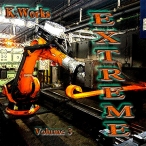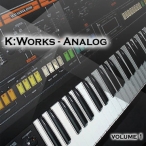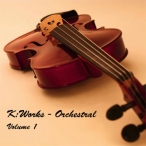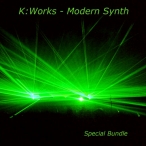KURZWEIL K2600 - Rewriting the Rules of Sound Design

Legendary Kurzweil K2600 - Power, Flexibility, and Inspiration in One.
Kurzweil K2600 is a DSP based, 127 algorithm, 48-voice polyphonic synthesizer/sampler workstation. It is the upgraded version of the famous K2000/2500 synthesizers with a completely redesigned circuit board and with the incredibly powerful Triple Modular Processing.
Kurzweil K2600 - Key Specifications and Features
Synthesis
The synthesis, this instrument uses, is called V.A.S.T., which stands for Variable Architecture Synthesis Technology. It is a unique system of pre-defined algorithms with a number of variables, individually editable DSP functions and digital oscillators, combined with the internal or external PCM samples.
There are 20 MB of onboard ROM (including the previously optional 4 MB Stereo Grand Piano) + 5 optional sample ROM boards - 8 MB Orchestral, 8 MB Contemporary, 8 MB Stereo Dynamic Piano, 8 MB Vintage Electric Piano or 8 MB General MIDI ROM) + max of 128 MB sample RAM.
With optional SMP-2X/R advanced sampling expansion boards, which add analog and digital sample inputs, K2600 works as a full sampler. Without SMP-2X/R installed, K2600 works as a fully functioning sample player.
The external RAM sample can be fully edited using the following functions; Sample Start, Attack, End, Cut/Copy/Paste; loop forward, backward, bi-directional looping and loop bypass; truncate, fade in, fade out, reverse, cross-fade looping with selectable curves and many other. Some of the above mentioned functions can be used with internal ROM samples as well.
PCM samples or digital oscillators (digitally generated waveforms like sine, sine+,LF sine, saw, saw+, LF saw, square, square+, LF square) can work together within any one of the total of 127 DSP algorithms. The new synthesizer processing engine expands the number of DSPs from 31 (on previous K2500) to 127. Algorithms can be combined in groups of three Layers connected in a serial manner. This feature is called Triple Mode Processing. There are 30 new algorithms available for Layer 1, 38 for Layer 2 and 26 for Layer 3 of Triple Layer. The algorithms for Layer 2 include a block that combines the output of Layer 1 with the sample assigned to Layer 2, and the algorithms in Layer 3 further process output of Layer 2. You can even combine a Triple Layer with normal Layers. Unfortunately, triple Layer uses the same polyphony as a normal three-layer Program.
As mentioned above, algorithms have variable segments, or in other words, individual DSP units. The algorithms are not rigidly defined as is the case with the Roland JD/JV and XV series but the types of DSP units in an algorithm can be changed. Each DSP is fully editable. K2600 can thus emulate several types of synthesis. This feature makes it really unique among other sample-based instruments.
Internal or external samples can be filtered (HPF, LPF, 12db/oct, 24db/oct, BPF, notch, peak, all pass, steep resonance), equalized (several EQ types), mixed with digital oscillators (digitally generated waveforms like sine, sine+, LF sine, saw, saw+, LF saw, square, square+, LF square), distorted and cross modulated.
Other DSPs available are shaper, high freq. stimulator, digital wrap, noise generator, PWM, X-Fade, amplitude modulation, panner, etc.
All individual parameters are fully editable (Hz, cent, dB, sec, msec settings, which offers significant advantages over the usual 1-127 convention).
There are 3 very fast envelope generators (AMPENV - amplitude envelope / ENV2, ENV3 user definable - 8 segments, looping), ENCTL (envelope control) for dynamic or continuous ADR parameters control, 2 LFOs (generators with many cyclic waveforms and adjustable phase angle between 0 – 270 degrees), 2 ASR envelopes for start and attack of user definable modulation functions, FUN (mathematical functions - formulas full of sin, cos, tg etc., for modulation of individual parameters of DSP algorithms e.g. pitch, filter, amplitude, pan, or direct control of LFO waveforms).
The modulation matrix is very complex. "Everything can be modulated by everything" (you can use functions for modulation source control as mixers, negators, invertors, sample and hold, quantization, ramp, shape, etc.).
Each sound program can consists of up to 32 layers.
KB-3 Drawbar Mode
KB-3 is now installed as a standard. It provides a powerful tone-wheel organ synth model, fully polyphonic over the keyboard. Each single voice contains nine harmonics that may be blended in real time using the sliders. There are 4 organ maps available with rotary speaker emulation, vibrato/chorus, percussion, key click, parametric EQ, etc.
Sober multitimbral
K2600 is a 16 channel multi-timbral synthesizer with a sophisticated "invisible" multi mode. Each preset or user program in Program Mode can simultaneously work on a different MIDI channel (1-16). This means that no complicated Multi or Performance mode is used for multi-timbral operations. There are two dedicated buttons on the panel to browse between individual channels/programs.
However for those who use the “Performances” and “Multis” the Setups are available as well.
Setups
There are several differences between programs and setups. Program can include several layers but plays only in one Zone on one MIDI channel. A setup enables user to utilise up to eight keyboard zones, each of which can have its own MIDI channel, program and control assignments. There can be up to 100 setups saved in each memory bank.
Sequencer
The K2600 internal sequencer is one of the best hardware sequencer ever made. It includes 32 fully editable tracks, 16 song and 16 arrangement tracks, 768 ppqn resolution and sequencer functions which include: Linear, Pattern and Step Drum Machine Record Modes, Reference Quantize, Non-destructive Track Editing, Cut, Copy and Paste facilities. Sequences can be triggered in real time from the keyboard (Advanced Auto Arranger functions). Another feature, called RAM Tracks, enables the sequencer to record audio signal along with the MIDI tracks. The audio data is saved in sample RAM rather than to hard disk. MIDI data is stored in Program RAM, however, this means that it uses your expensive and limited P-RAM capacity.
Program/ Sequence RAM
1.5 MB user-programmable battery-backed RAM. Equivalent to over 360,000 sequencer events.
KDFX effect processor
Unlike with the previous models, K2600 offers the KDFX effect board as a standard. KDFX is an advanced digital reverb and effect unit with digital I/O and superb sonic possibilities. It is based on Kurzweil´s VLSI chip. Available effects include 15 reverbs, 7 delays, 11 modulation algorithms (chorus/flange/phaser), 9 distortions, 5 tonewheel organ effects, 14 special effects (filters, shapers, etc.), 24 multi-effects, and 21 studio/mixdown effects (compressors, expanders, gates, and Eqs, tremolo, enhancers, autopanners, stereo image manipulators, and SRS simulated 3D). VLSI DSP chips can be upgraded with new software. There are 4, full bandwidth, stereo buses, 8 outputs and 2 inputs of Kurzweil Digital Stream (KDS) digital I/O (this requires DIO26 option for connection with DMTi) and flexible routing scheme.
Vocoder
With the optional sampling SMP-2X/R upgrade, the K2600 can also work as a vocoder. Vocoder reduces the polyphony in proportion to the number of used filter bands (up to 24, two notes are used per filter band). The vocoder may be combined with the Live mode.
Microtonal tuning
There are 17 pre-programmed intonation tables all of them are freely user editable.
Polyphony
The polyphony is 48 voices (together with a maximum of 192 oscilators - 48 sample playback and 144 synthesizer waveforms). Special voice allocation system, first patented for K250, is used. This system analyses the most frequently used sounds in multi-timbral mode so the "voice stealing" effect is nowhere near as obvious as with other synthesizers. Each program can consist of up to 32 layers.
"Gameboy" inside :)
A tired programmer can play the computer game called "Pong" on the K2600 display.
Sounds never before imaginable
The instruments has a unique and "fat" sound, and is excellent in multitimbral settings. It is not necessary to "sweeten" the sound with reverbs. The rich editing functions expanded by the awesome Triple Mode offer immense sound possibilities for analog emulations. The instrument offers superb acoustic sounds, excellent pads, as well as extreme non-harmonic digital colors. K2600 is useful for all music styles and is excellent for electronic and techno music. With the right soundware, K2600 can easily outperform all VA synthesizers. To evaluate the instrument's capability, please listen to our K:Works Modern Synth demo here, and K:Works Gold demo here.
Plus:
• Excellent sound
• Programmability (a beginner could be easily scared off by the multitude of parameters, but the OS is
well arranged and logically organized) Virtually limitless Triple Mode
• Multitibral - easy and quick operation - no complicated performance or multi sounds settings
• KB3 Drawbar mode
• Sophisticated Arpeggiator
• Quick Access Mode
• Advanced File Management System (AFMS) – AFMS provides user friendly cataloguing and retrieval
of individual objects
• Program list (besides the active sound program there are other 5 neighbouring sounds displayed for
better orientation, which is an excellent idea
• Flash ROM OS for software updates via floppy disk and SCSI
• MS-DOS compatibility
• CD-ROM compatibility (Akai, Ensoniq, Roland, MS Windows Wav, Mac AIFF)
• Downward compatibility with K2000/2500 models (emulation disks necessary)
• Control sliders and ribbons
• Expandability (RAM, ROM, HDD)
• Excellent KDFX effect processor
• Vocoder (requires sampling option installed)
• Live Mode (requires sampling option installed)
• Analog Outputs (5 pairs)
• Various digital OUT formats including ADAT
• New upgrades available - Stereo Dynamic Piano, Vintage Electric Piano and General MIDI ROMs
Minus:
• Absence of a USB port
• High expansion module prices – 1 MB of P-RAM is probably the most expensive 1 MB RAM money
can buy
• 48-voice polyphony only, not enough for especially in Triple Mode settings
• Small display
• Still same internal ROM samples as on K2500 with only few improvements
• P-RAM expansion is necessary to use the K2500 emulation disk
• Aliasing on some internal ROM samples and digital oscillators
Web resources
http://kurzweil.com/ - Kurzweil Music Systems company web page
| |
|
|
|
|
|
|
|
|
-

K:Works - Extreme - Volume 3 "LE" (Kurzweil K2600/K2600R)
€27.45 -

K:Works - Analog - Volume 1 "EX" (Kurzweil K2600/K2600R)
€29.95 -

K:Works - Orchestral - Volume 1 "EX" (Kurzweil K2600/K2600R)
€69.95 -

K:Works - Modern Synth "EX" - Special Bundle (Kurzweil K2600/K2600R)
Regular Price: €179.00
Special Price: €107.40



